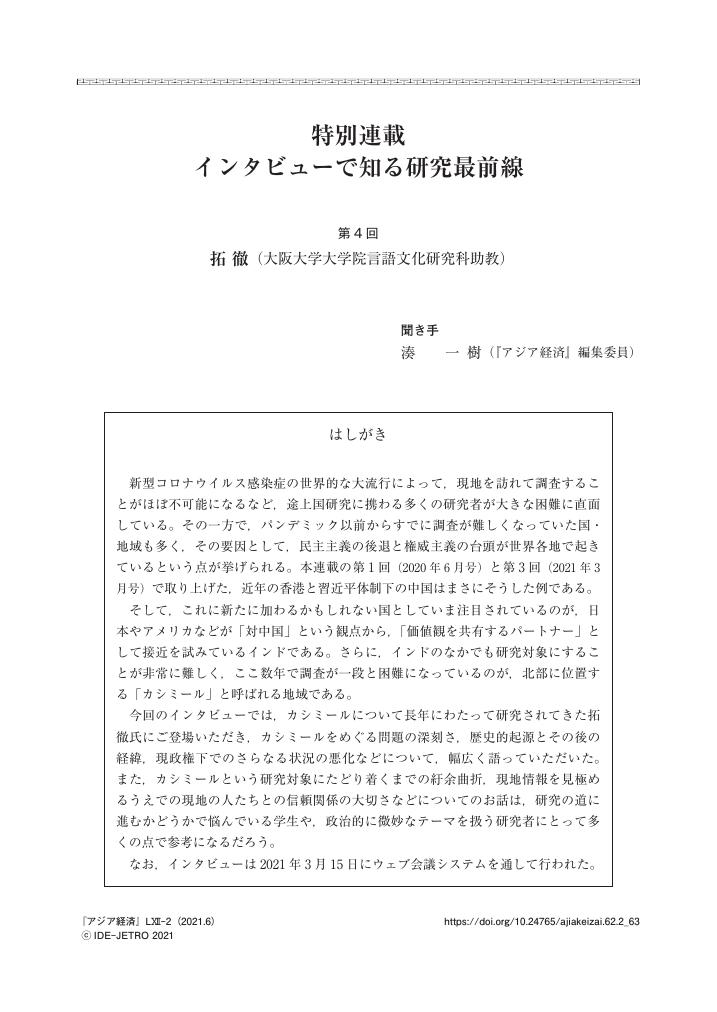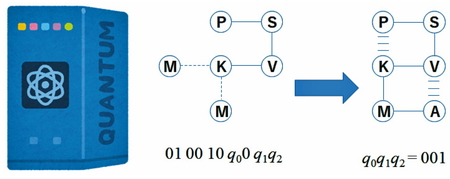32 0 0 0 OA インタビューで知る研究最前線 第4回
- 著者
- 拓 徹 湊 一樹
- 出版者
- 独立行政法人 日本貿易振興機構アジア経済研究所
- 雑誌
- アジア経済 (ISSN:00022942)
- 巻号頁・発行日
- vol.62, no.2, pp.63-85, 2021-06-15 (Released:2021-07-03)
- 参考文献数
- 5
- 著者
- 山口 知彦 河原 明彦 湊 宏 大田 俊一郎 藤吉 啓造 牛嶋 公生 嘉村 敏治 鹿毛 政義
- 出版者
- 特定非営利活動法人日本臨床細胞学会
- 雑誌
- 日本臨床細胞学会雑誌 (ISSN:03871193)
- 巻号頁・発行日
- vol.47, no.2, pp.86-94, 2008-03-22
- 参考文献数
- 23
- 被引用文献数
- 3
21 0 0 0 OA 第2次世界大戦の日本の戦略的意思決定の分析
- 著者
- 湊 晋平 Shinpei Minato 元松山大学経営学部教授
- 雑誌
- 松山大学論集 = Matsuyama University review (ISSN:09163298)
- 巻号頁・発行日
- vol.23, no.3, pp.145-169, 2011-08-01
20 0 0 0 OA 「おねえさんの問題」の最先端 -YouTube動画と世界記録-
「おねえさんの問題」と呼ばれる格子グラフ上の経路数え上げ問題が,アルゴリズムの専門家のみならず,情報処理関連の研究者・技術者の間でも広く注目を集めている.本稿では,まず「おねえさんの問題」という名称の由来について述べ,この問題を効率よく解くためのデータ構造「ZDD」とKnuth のZDD 構築アルゴリズムについて簡単に解説する.次に,この問題が知られるきっかけになった日本科学未来館における研究成果展示とYouTube 動画の反響について振り返り,最近達成された世界記録の状況について述べる.最後に,この問題が高速に解けることで今後どのような応用が期待できるかを展望する.
17 0 0 0 化学熱傷
- 著者
- 湊原 一哉
- 出版者
- 公益社団法人 日本皮膚科学会
- 雑誌
- 日本皮膚科学会雑誌 (ISSN:0021499X)
- 巻号頁・発行日
- vol.117, no.7, pp.1121-1127, 2007-06-20 (Released:2014-12-03)
- 被引用文献数
- 1
化学熱傷とは酸やアルカリを代表とする様々な化学薬品によって引き起こされる熱傷様の皮膚・粘膜障害である.その病態は刺激性接触皮膚炎の範疇に位置付けられている.原因となる化学物質は膨大な数におよぶ.そのため,初期の対応にとまどうことが少なくない.本稿では原因となる主な物質の分類と作用機序,診断時のポイント,および一般的な治療について述べ,さらには本邦でこれまで報告された症例をもとに具体的な事例についてまとめた.
15 0 0 0 OA 桜島火山における反復地震探査(一回目)
- 著者
- 筒井 智樹 井口 正人 為栗 健 上田 義浩 大島 弘光 植木 貞人 大湊 隆雄 及川 純 市原 美恵 野上 健治 中道 治久 大倉 敬宏 清水 洋 宮町 宏樹 八木原 寛 前川 徳光 堀川 信一郎 吉川 慎 園田 忠臣 平野 舟一郎 末峯 宏一 林 幹太 加藤 幸司 長尾 潤 池亀 孝光 松末 伸一 五藤 大仁 河野 太亮 簗田 高広 田中 窓香 渡辺 竜一 長岡 優 前原 祐樹 吉田 沙由美 小林 由実 栢橋 志郎
- 出版者
- 京都大学防災研究所
- 雑誌
- 京都大学防災研究所年報. B = Disaster Prevention Research Institute Annuals. B (ISSN:0386412X)
- 巻号頁・発行日
- vol.53, no.B, pp.241-260, 2010-06-01
11 0 0 0 OA インタビューで知る研究最前線 第3回
- 著者
- 武内 宏樹 湊 一樹 内藤 寛子
- 出版者
- 独立行政法人 日本貿易振興機構アジア経済研究所
- 雑誌
- アジア経済 (ISSN:00022942)
- 巻号頁・発行日
- vol.62, no.1, pp.50-72, 2021-03-15 (Released:2021-03-25)
- 参考文献数
- 3
10 0 0 0 OA 長崎県多良岳のヤマネ
10 0 0 0 OA 日本における地表γ線の線量率分布
- 著者
- 湊 進
- 出版者
- Tokyo Geographical Society
- 雑誌
- 地学雑誌 (ISSN:0022135X)
- 巻号頁・発行日
- vol.115, no.1, pp.87-95, 2006-02-25 (Released:2009-11-12)
- 参考文献数
- 55
- 被引用文献数
- 21 23
Nationwide in-situ measurements of terrestrial gamma ray dose rates have been carried out using a scintillation counter. A database of over 4300 entries has been compiled by adding data taken from literature to the data collected by the mentioned survey. A contour map of dose rates in Japan calculated from the database is presented along with a table of dose rates for each bedrock type.
突然に発症し致死率の高い急性大動脈解離に関して、全国規模の診療データベースがなく、診療エビデンスも少ない。本研究においては、心臓血管外科に関する全国規模の悉皆性データベースであるNCD内のJCVSDと血管外科データベースに期間限定で追加項目を設定し、さらにステントグラフト実施基準管理委員会のデータも加え、急性大動脈解離の外科治療に特化したデータベースを作成し外科診療の実態を把握する。重篤かつ致死的な急性大動脈解離の克服のための全国規模の網羅的診療基盤データとして初めての試みであり、「脳卒中・循環器対策基本法」の対象疾患である急性大動脈解離の救急診療体制作りの基礎データとして有用と考える.
8 0 0 0 OA 船底の汚れに因る船體抵抗の増加
- 著者
- 出淵 巽 藤嶋 範平 荒木 勤 出淵 巽 山本 武藏 菅 四郎 湊 一磨 平賀 譲
- 出版者
- 公益社団法人日本船舶海洋工学会
- 雑誌
- 造船協會會報 (ISSN:05148499)
- 巻号頁・発行日
- no.55, pp.57-100, 1935-03-25
The effect of fouling upon the resistance of ships was examined by the towing experiments with the ex-destroyer Yudachi at various stages of fouled surface after 4,75,140,225 and 375 days out of dock ; the speeds experimented with were up to 20 knots at each fouled condition. After these experiments the author studied the effect of fouling on the propulsive efficiency applying the above-mentioned results of towing experiments to the trial results of a first-class destroyer. The chief conclusions drawn from these investigations are : (1) Frictional resistance of ships having fouled bottoms can be expressed by the following formula : -R_f=f S V^<2-1>, where R_f=frictional resistance in kg., S=wetted surface area in m^2., V=speed of ship in knots, f=coefficient of frictional resistance which varies with the weight of fouled substances per unit area as shown in Fig.6. (2) Propulsive efficiency is affected scarcely by the bottom fouling.
- 著者
- 岩崎 統 湊 和雄
- 出版者
- 日本応用動物昆虫学会
- 雑誌
- 日本応用動物昆虫学会大会講演要旨
- 巻号頁・発行日
- no.29, 1985-04-01
7 0 0 0 IR EU諸国のボローニャ・プロセスと複合文化社会における教員養成課程改革(1)
- 著者
- 石井 バークマン 麻子 湊 七雄 中澤 達哉
- 出版者
- 福井大学
- 雑誌
- 福井大学教育地域科学部紀要. 第IV部, 教育科学 (ISSN:13456059)
- 巻号頁・発行日
- vol.63, pp.1-34, 2007-12-14
6 0 0 0 OA 量子コンピュータを利用したタンパク質の畳み込みモデル
- 著者
- 齊藤 瑠偉 奥脇 弘次 望月 祐志 永井 隆太郎 加藤 拓己 杉﨑 研司 湊 雄一郎
- 出版者
- 日本コンピュータ化学会
- 雑誌
- Journal of Computer Chemistry, Japan (ISSN:13471767)
- 巻号頁・発行日
- vol.21, no.2, pp.39-42, 2022 (Released:2022-11-16)
- 参考文献数
- 16
- 被引用文献数
- 1
We have performed a series of quantum computations for folding of the PSVKMA peptide by using the blueqat AutoQML simulator by which a given problem can be converted from QUBO (quadratic unconstrained binary optimization) of quantum annealing to QAOA (quantum approximate optimization algorithm) of VQE (variational quantum eigensolver). The IonQ quantum system of ion-trap type was utilized as well. A three qubit problem was successful by both. However, the situation became difficult for a five qubit case, especially for the IonQ having vulnerability to noises.
6 0 0 0 OA ヤマネを守り、森を守る : 持続可能な社会を目指して
- 著者
- 湊 秋作 Shusaku Minato
- 雑誌
- 関西学院大学スカイセミナー : Sky Seminar
- 巻号頁・発行日
- no.87, 2011-08
6 0 0 0 スペクトルモーフィングによるグロウル系統の歌唱音声合成
- 著者
- Bonada Jordi Blaauw Merlijn 才野 慶二郎 久湊 裕司
- 出版者
- 一般社団法人情報処理学会
- 雑誌
- 研究報告音楽情報科学(MUS)
- 巻号頁・発行日
- vol.2013, no.24, pp.1-6, 2013-08-24
音声,特に強め表現を伴う歌声においてはしばしば声帯振動に基本周期外の不規則な挙動が見られる.本稿ではこのような声質を持つ音声を再現するためのスペクトルモーフィングに基づいた音声合成手法について述べる.本手法は,ターゲットとなる声質を持った音声サンプルの励振源に相当する成分と,入力音声のスペクトル包絡を用いて合成を行うものである.まず,声質ターゲットサンプルに対し,その基本周波数を入力音声の基本周波数に合わせこむための時間領域リサンプリング処理を行う.その後,声質ターゲットサンプルのスペクトルの元々の包絡構造をなるべく復元するように,調波成分の再配置を行う.最後に,そこに入力音声の調波の振幅と位相を適用することで,入力音声の音色と声質ターゲットサンプルの声質を併せ持つ音声信号を得る.その音声信号と入力音声を任意の比率でモーフィングすることで,声質ターゲットサンプルの声質を任意の分量だけ持つ音声が合成可能となる.本稿では,グロウルの声質を持つ音声を使用した歌声合成および主観評価実験を行った.In this paper we introduce a morph-based approach for generating voice source aperiodicities frequently associated with strong vocal expressions, especially in singing. In our approach the excitation characteristics of one signal are combined with the fundamental frequency and spectral envelope characteristics of another signal. An exemplar sustained sample of the target voice quality is resampled in the time domain in order to generate a continuous signal matching the input voice's fundamental frequency. While we found the temporal scaling to be acceptable in many contexts, the frequency scaling has to be inverted in order to generate appropriate spectral content for the source excitation's entire bandwidth. Finally, the input signal's harmonic amplitudes and phases are applied to the transformed morph sample, allowing for a simple one-dimensional control of morph amount by linear interpolation with the input signal. The proposed system is evaluated and the results are discussed.
5 0 0 0 OA 環境化学物質による次世代の性ホルモンへの影響
- 著者
- 荒木 敦子 伊藤 佐智子 宮下 ちひろ 湊屋 街子 岸 玲子
- 出版者
- 一般社団法人日本衛生学会
- 雑誌
- 日本衛生学雑誌 (ISSN:00215082)
- 巻号頁・発行日
- vol.73, no.3, pp.313-321, 2018 (Released:2018-09-29)
- 参考文献数
- 60
- 被引用文献数
- 1 1
In recent years, the birthrate has been continuously declining in Japan. The main causes of the decline are social factors. On the other hand, there is increasing evidence that many environmental chemicals show endocrine disrupting properties. Thus, we hypothesized that exposure to these chemicals would also be a causal for the fertility crisis. In this review, we examined current evidence that focused on environmental chemical exposure in utero and its association with reproductive hormones in children. We have included the findings from a prospective birth cohorts, the Hokkaido Study on Environment and Children’s Health Sapporo cohort. According to the literature, environmental chemical levels in utero, such as polychlorinated biphenyl, dioxins, perfluorinated chemical substances, phthalates, and bisphenol A were somewhat associated with the levels of reproductive hormones, such as testosterone, estradiol, progesterone, inhibin B, and insulin-like factor-3 in cord blood, in early childhood and adolescence. The literature also suggests the association between exposure to these chemicals and brain-sexual differentiation or the anogenital distance, which suggests the disruption of androgen shower during the developmental stage in the fetal period. There are still knowledge gaps on whether these hormones at an early stage affect the pubertal development and reproductive functions in later life. In addition, alternative chemicals are produced after banning one type. The health effects of alternative chemicals should be evaluated. Effects of exposure to a mixture of the chemicals should also be examined in future studies. In conclusion, the prevention of environmental chemical hazards in relation to human reproductive function is important. It would be one of the countermeasures to the falling birthrate caused by fertility issues.
5 0 0 0 海上気象及海洋觀測船凌風丸
5 0 0 0 OA IRマインドを涵養する評価人材の育成プログラムの構築に関する研究
- 著者
- 嶌田 敏行 小湊 卓夫 浅野 茂 大野 賢一 佐藤 仁 関 隆宏 土橋 慶章 淺野 昭人 小林 裕美 末次 剛健志 難波 輝吉 藤井 都百 藤原 宏司 藤原 将人 本田 寛輔
- 出版者
- 茨城大学
- 雑誌
- 基盤研究(C)
- 巻号頁・発行日
- 2012-04-01
大学の諸課題の数量的・客観的把握を促すIRマインドの形成を目指した評価・IR人材の能力定義、教材の開発、教育プログラムの開発および体系化を行った。そのために単に研究・開発を行うだけでなく、様々な研修会や勉強会を開催し、全国の評価・IR担当者の知見を採り入れた。そのような成果を活かして、評価・IR業務のデータの収集、分析、活用に関するガイドラインも作成し、評価現場やIR現場で活用いただいている。加えて、合計14冊(合計940ページ)の報告書を作成した。この報告書は自習用教材としての活用も意識した構成とし、すべてwebページを作成し公表している。
5 0 0 0 文学という妖夢 (セクシュアリティ<特集>)
- 著者
- 川村 湊
- 出版者
- 早稲田文学会
- 雑誌
- 早稲田文学 〔第8次〕 (ISSN:03881970)
- 巻号頁・発行日
- no.156, pp.p42-46, 1989-05




